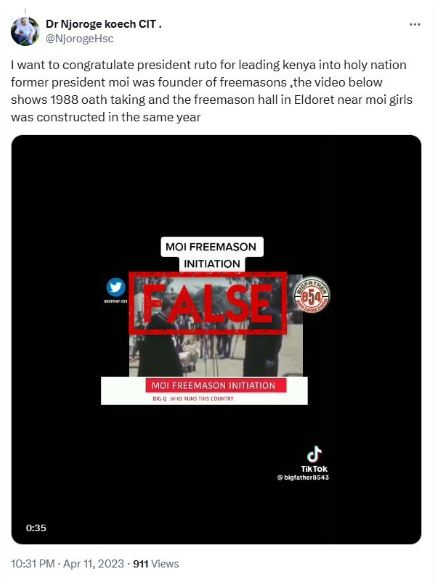Amid rising tensions between Kenya’s church leaders and President William Ruto, a controversial video has surfaced, claiming to showcase the late Daniel arap Moi, the country’s second president and a significant figure from Ruto’s ethnic community, being inducted into Freemasonry. This claim has sparked considerable discussion, particularly since Freemasonry is often associated with devil worship in Kenya, where over 80% of the population identifies as Christian. However, the assertion is unfounded; the video actually dates back to 1980, capturing Moi’s investiture as a Knight of Grace of the Order of St John—a humanitarian organization devoid of any ties to Freemasonry. This misinterpretation has not only persisted but also found new life amid political strife, further complicating the already sensitive relationship between Ruto’s government and religious institutions in Kenya.
On October 15, 2024, a clip featuring Moi in a ceremonial black cloak drew attention after being shared on the platform X, along with the misleading caption that claimed he was being inducted into the Freemasons. The video shows Moi alongside others in similar attire during what appears to be an investiture ceremony. The spread of this disinformation is particularly noteworthy within the Kenyan context, where perceptions of Freemasonry are clouded by accusations of associations with occult practices. In the past, church leaders in Kenya have stoked fears surrounding Freemasonry, leading to the establishment of a commission of inquiry into cult and devil worship in 1994 under Moi’s administration.
The resurgence of the video coincides with mounting backlash against President Ruto from church leaders, who have accused him of deception, heavy taxation, and corruption, among other grievances. There are suspicions that these false assertions about Moi—and, by extension, Ruto—are being politically weaponized in the ongoing struggle between religious figures and the government. The accusations linking Ruto to Freemasonry, whether from church leaders or social media users, appear to be an attempt to undermine his political credibility. This association resonates with the historical narrative in which Moi’s presidency was characterized by control over religious discourse, thereby aggravating present tensions arising from Ruto’s recent governance challenges.
The video has been resurrected in various forms over the years for different narratives, showcasing its adaptability and versatility in Kenya’s political climate. For instance, during the 2022 election, the clip was utilized to both ridicule and praise Ruto, depending on the political agenda being put forth. Supporters of Ruto reframed the narrative, portraying him as a leader steering Kenya toward a moral revival in contrast with the alleged sins of past leaders like Moi. Conversely, critics employed the video to insinuate that Ruto’s affiliations with past political figures were suspect, thus pushing the narrative that he is not as virtuous as he claims. This duality underscores the intricate relationship between visual media, politics, and public perception in Kenya.
The origins of the video have been verified through reverse image searches, tracing it back to British Pathé, where it was cataloged as news footage of Moi’s investiture into the Order of St John on March 18, 1980. This Christian order is involved in charitable activities and holds no affiliations with Freemasonry, albeit sharing some symbolic overlap with regard to its patron saints. The actual investiture ceremony involved Moi receiving a mantle, which was emblematic of his commitment to uphold Christian values and serve the less fortunate. Understanding the true context of this footage dismantles the narrative linking Moi—and by extension Ruto—to the controversial secretive practices of Freemasonry.
Overall, the revitalization of the video serves as a case study in how misinformation can manipulate historical narratives for contemporary political ends. The complexities of faith, governance, and public perception in Kenya highlight how easily misunderstandings can shape social discourse. As Ruto continues to face scrutiny from religious institutions and the public alike, the use of misleading visuals like that of Moi’s investiture demonstrates an enduring struggle for political legitimacy and control over historical memory. Thus, this incident encapsulates not only the ongoing tensions in Kenyan politics but also the broader challenges of navigating information in a society intensely tied to its religious ideologies.

